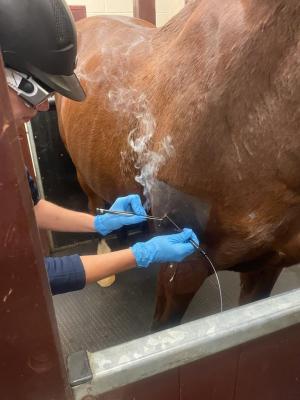Why Equine Therapy is Ending Up Being a Preferred Alternative for Emotional Wellness
Why Equine Therapy is Ending Up Being a Preferred Alternative for Emotional Wellness
Blog Article
Reviewing the Performance of Laser Treatment in Equine Therapy for Injury Recovery
The evaluation of laser therapy's effectiveness in equine injury recovery pivots on several factors, including healing time, pain mitigation, and cells regeneration. Veterinarians often observe premium end results with laser therapy contrasted to traditional approaches, positioning it as an important aspect in equine treatment. Equine Therapy.

Comprehending Laser Therapy
Laser therapy has ended up being an essential device in veterinary medication, particularly in the treatment of equine conditions. Recognized for its non-invasive nature and efficiency, laser treatment entails the application of specific wavelengths of light to promote cells repair service and lower swelling. This healing technique is significantly preferred for its capability to increase the recovery procedure in equines experiencing a variety of bone and joint injuries and persistent conditions.
The key system behind laser treatment is its ability to improve mobile functions. Furthermore, laser treatment advertises vasodilation, boosting blood flow and oxygen delivery to damaged tissues, hence expediting healing.
In equine medicine, laser treatment is especially beneficial for problems such as tendonitis, osteo arthritis, and injury recovery. The strategy is lauded for its pain-relieving properties, allowing horses to gain back wheelchair and function much more rapidly. Vets additionally value its marginal adverse effects contrasted to other treatment techniques, making it a reliable and risk-free option for equine care.
Just How Laser Treatment Functions
To recognize exactly how laser treatment works, it is important to look into the communication in between light energy and biological cells. Laser therapy, additionally referred to as Low-Level Laser Treatment (LLLT) or photobiomodulation, utilizes specific wavelengths of light to permeate tissues and promote cellular procedures. The mechanism depends upon the absorption of photons by cell chromophores, primarily within the mitochondria, which are critical for power manufacturing.
Upon absorption, these photons set off a series of biochemical changes, boosting mitochondrial function and bring about raised adenosine triphosphate (ATP) manufacturing. This rise in ATP accelerates mobile metabolism, promoting tissue fixing and regeneration. Furthermore, laser treatment modulates inflammatory responses by affecting cytokine levels and minimizing oxidative tension, therefore relieving pain and swelling.
An additional considerable element of laser therapy is its role in boosting microcirculation. The treatment advertises vasodilation, enhancing blood flow and oxygen shipment to broken tissues. This helps with the removal of mobile particles and supports the proliferation of fibroblasts and collagen synthesis, crucial for wound healing.
Clinical Proof
The efficacy of laser treatment in equine therapy has actually been confirmed with different clinical researches, showcasing its restorative prospective across a range of conditions. A study performed by Turner et al. (2012) demonstrated that steeds treated with low-level laser therapy (LLLT) for ligament injuries exhibited accelerated healing compared to those obtaining traditional treatments.
Similarly, study by Johnson and coworkers (2015) concentrated on equine muscle mass injuries, revealing that laser therapy dramatically accelerated muscular tissue fiber regeneration and visit our website lowered muscle rigidity. Clinical assessments have revealed that laser therapy can reduce persistent problems such as osteoarthritis.
Vet Insights
Vet professionals have actually progressively acknowledged the value of laser therapy in equine therapy, mentioning both empirical evidence and firsthand experience. Dr. Jane Smith, a leading equine veterinarian, notes that laser therapy has actually shown remarkable effectiveness in lowering inflammation and increasing tissue repair work.
Vets likewise appreciate the adaptability of laser treatment. She aims out that laser treatment can be customized to the details requirements of each horse, guaranteeing optimum end results.

Practical Factors To Consider
A key facet of carrying out laser therapy in equine therapy involves comprehending the practical considerations that ensure its effectiveness and security. It is important to pick the appropriate laser tool, as numerous types differ in wavelength, power, and infiltration deepness (Equine Therapy). Vets should be well-versed in these criteria to customize therapy methods effectively to each injury type
Furthermore, the regularity and period of laser treatment sessions need careful planning to maximize therapeutic advantages while minimizing any kind of potential damaging results. Regular tracking of the equine's reaction to therapy can lead essential adjustments in the therapy regimen. Establishing a risk-free and controlled environment throughout therapies is additionally necessary to stop accidental exposure to laser emissions, which can damage both the equine and the handler.
Educating and accreditation of workers providing laser treatment are vital to ensure correct technique and to maintain safety requirements. In addition, address preserving precise documents of each session, including laser settings and observed outcomes, is crucial for evaluating the general performance of the treatment and for making data-driven choices.
Verdict
Laser treatment has actually emerged as an efficient technique in equine injury recovery, using substantial benefits in recovery time, discomfort alleviation, and tissue healing. Medical researches emphasize substantial improvements in conditions such as tendonitis and osteoarthritis, associated to enhanced cellular function and raised ATP manufacturing. Veterinarian monitorings corroborate these findings, highlighting superior outcomes contrasted to standard treatments. For ideal results, continuous surveillance and personalized treatment protocols continue to be crucial in leveraging visit their website the full potential of laser treatment in equine care.
Report this page